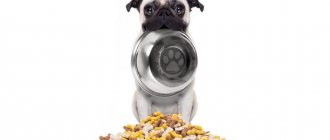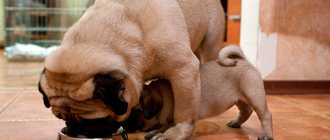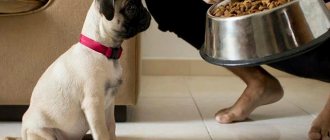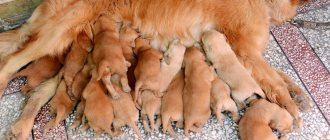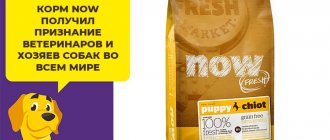Pugs are small, cute and cheerful dogs, always ready to participate with their owners in all family matters.
Like other pets, they require attention and proper care. First of all, pugs need to choose the right diet, since not only the mood, but also the health of the dog depends on it.
A well-prepared balanced diet is one of the important aspects of maintenance. Violation of the regime and improper feeding can lead to weakened immunity and the appearance of various diseases in the pet.
Puppies of this breed need to be fed more often than adult pugs. Large dogs are prone to obesity, so they need to be fed less often.
In this article we will look at what pug nutrition should be like, what options there are and which one is better.
First food for a small dog
Pug litters are rarely large, with an average of 2 to 5 puppies born. This amount is optimal for natural feeding. However, in some circumstances, for example when the bitch has little milk and the puppies are not gaining weight well, it is recommended to introduce early complementary foods.
An objective signal for the decision to introduce complementary foods is a log of the puppies' weight gain. If there is no weight gain within 3 days, the puppies behave restlessly, squeak and pick at their nipples - it is necessary to introduce additional nutrition. Before 3 weeks of age, they cannot digest meat or processed food.
How to do it right?
Cow's milk, due to its high lactose content, is also poorly digestible. The best option would be to use a specialized milk formula. It is diluted in the proportions specified in the instructions, usually 30 ml of water per 1 measuring spoon, and heated to 36 degrees.
Milk is given through special bottles, or poured into a syringe with the needle removed. If necessary, such a substitute can be given from the first day.
How to avoid obesity?
Obesity is a serious disease of pugs, which is diagnosed very often in this breed of dog.
The owner's excessive care to ensure that his pet is always well-fed is usually to blame. Such a misconception can lead to negative consequences and contributes to the development of various diseases, such as diabetes mellitus and cardiovascular pathologies.
NOTE!
Compliance with the diet is the key to good health and long life of the pug. That is why, if you notice that your pet has become more obese, you need to contact a veterinarian, who will give recommendations on the dog’s diet for obesity and create a diet.
But before starting treatment, you need to understand what reasons led to excess weight.
Some of the most common reasons:
- overfeeding _ Overdose of food or fatty, high-calorie foods;
- lack of physical activity . If the pet is taken out for a walk for too short a time;
- metabolic disease . A slow metabolism will contribute to extra pounds;
- stress _ Moving, adding another pet to the house, changing owners - all this can lead to nervous stress. It often happens that dogs, just like people, “eat stress,” which affects their weight;
- genetic predisposition . If your pug had obese ancestors in his pedigree, then he is very likely to be obese too;
- hormonal disorder . Hormones that slow down dissimilation processes contribute to weight gain;
- worms . Toxic substances secreted by helminths provoke a slow metabolism.
Dog obesity cannot be ignored. There are many health problems - the heart has to work harder. Cholesterol levels are elevated, which leads to blockage of blood vessels and the formation of plaques, impairing blood flow. High blood pressure in obese dogs is fraught with serious complications and is dangerous for the blood vessels of the brain.
A large load falls on the musculoskeletal system. Excess weight causes joints to become deformed. Subsequently, diseases develop - arthrosis, osteochondrosis, etc.
Also, a large load falls on the liver, causing it to become fat. High concentrations of bilirubin cause jaundice, which can affect the dog's brain.
Obesity in a dog leads to problems with the dog's heat exchange, a weakened immune system, loss of sexual function and metabolic disorders, which causes the dog to get even fatter.
Medical statistics are disappointing - overweight pets live 1.5 years less than pets of normal weight.
Problems also arise for the owner, since he will have to spend additional money on special food, dietary food and treatment for the dog. We must try to avoid these problems.
The question arises, what to do and how to help a pug lose weight? You should immediately visit a veterinarian, who will make adjustments to the diet and possibly prescribe medication.
How many times a day is it possible?
Immediately after birth, puppies eat very often. The rest of the time they sleep. If the litter is entirely bottle-fed, there are two feeding plans for pug puppies.
In the “on demand” mode, the mixture is given at the moment when the puppies begin to behave restlessly. However, this regime is extremely difficult for the breeder, due to the uneven load throughout the day.
It is much more productive to use the “time-based” mode. In the first week, puppies need to be fed every 2 hours during the day and about 3 times at night. For example, starting in the morning at 6, at 8, 10, 12, 14, 16, 18, 20, and then at 23, 2 in the morning, 4 in the morning. At the rate of ½ teaspoon of dry mixture per puppy per feeding.
What to feed puppies and lactating bitches?
The diet of puppy and lactating pug bitches is no different: vitamin and mineral supplements and calcium supplements should be added to the main food. For the first 7-10 days, the bitch’s diet should not include meat, as it can cause a disease such as eclampsia , characterized by severe spasms and convulsions.
Sometimes owners of puppy dogs and lactating bitches note that the dog either refuses food or begins to be picky: it may refuse meat in favor of pickles or ice cream, for example. You shouldn't follow your pet's lead . You should simply double the amount of vitamins and give a piece of liver or vitamin K every day. And at the same time, check the dog’s temperature, in case the reason for refusing food is more serious.
Pugs are wonderful animals. And if a person provides the pet with everything necessary, in particular, high-quality food, then the dog will definitely respond to him with mutual love and devotion.
What do they eat at 2 weeks of age?
By the second week of life, puppies' needs for formula increase, but they still cannot digest lactose. Therefore, it is optimal to continue using bitch milk substitutes.
For example:
- Bosch Puppy Milk milk replacer for dogs;
- Royal Canin Babydog Milk;
- Canina Welpenmilch and others.
The amount of the finished mixture is doubled. The feeding regimen remains the same.
In cases where it is not possible to use a ready-made mixture, it is possible to use heated goat’s milk with a quail egg yolk added to it. The need to add an egg is explained by the fact that bitch milk has a much higher percentage of fat content than goat milk.
Prohibited Products
Many loving owners pamper their beloved pugs with prohibited foods, unaware of the sad consequences of such treats. To avoid the development of bad habits and serious pathologies, it is highly recommended not to feed your nimble baby the following foods:
- Sweets. Cunning fatties love sweets very much, but you should not feed your beloved kids sweets and cakes to avoid the destruction of tooth enamel, the development of diabetes and obesity. An alternative sweet treat for pugs is honey and fruit, which meet the growing body's glucose needs.
- Smoked meats, sausages and spicy foods. Seasonings and preservatives contained in sausage and smoked products contribute to the development of gastritis and gastroenteritis in young dogs.
- Pork, fatty and fried foods. Fatty foods with prolonged feeding can cause irreversible degenerative changes in the animal’s liver.
- Bones. The common belief that a puppy should be treated to bones is erroneous. It is highly recommended not to give pugs bird and rabbit tubular bones to avoid damage to the thin intestinal lining from the sharp edges of the bones. Boiled bones thicken stool and cause constipation. Babies can be given small soft lamb and veal bones, previously beaten with a hammer, or a large beef sugar bone.
Nutrition for a 3 week old
In the third week, the daily dosage for a pug puppy increases to 1 ½ teaspoons of dry mixture. Feeding occurs at intervals of 2-3 hours, a total of 8 times per day. By the end of the week, you can introduce the first meat supplement.
To do this, take lean meat, such as veal or turkey. Raw meat is ground in a blender until pureed and given to the puppies. For the first time, the volume of the meat ball should be no larger than a bean. Gradually the size increases to half a tennis ball.
Vaccination
Vaccination is a mandatory procedure to maintain the health of your pet. Before the puppy develops immunity, it should not be taken outside or allowed to come into contact with other animals.
Before the first vaccination, your pug puppy needs to be dewormed. This is done about a week before the procedure.
The first vaccination is given at 2 months. Repeated - after 21 days, until the puppy’s teeth change.
A certified clinic will definitely create a veterinary passport, which will include all the notes. Prices in Moscow start from 400 rubles.
The first walk after vaccination is possible after a week and a half.
Diet for 1 month
At week 4, the daily volume is 3 teaspoons of dry mixture per 1 pug puppy. Feeding intervals are maintained, the total amount also reaches up to 8 times. Gradually, one feeding with formula is completely replaced with meat.
The pug is a breed prone to allergies, so the introduction of any new products should begin with small portions and with mandatory monitoring of the reaction.
You can often find a recommendation to give soaked dry food as the first complementary food. However, puppies most often are not interested in it, since they get enough nutrients from bitches’ milk. Unlike dry food, meat almost always arouses keen interest.
Also during this period you can introduce homemade cottage cheese .
For this purpose, 3.2% milk is taken. Kefir has the same fat content – 3.2%. Half a liter of milk is poured into the pan, then you need to heat it until hot and add kefir (also half a liter).
Reduce the heat to low and watch when curds begin to form on the surface, and yellow-greenish whey underneath.
Turn off the heat and let stand for a while. Homemade cottage cheese is ready!
When the cottage cheese has cooled, give it to the puppies. The dogs happily drink the remaining whey.
The proportions milk/kefir are approximately 1/1. You can use a little more milk than kefir.
After 2-3 days from the beginning of introducing the product into the diet, in the absence of negative reactions, one feeding with the mixture is completely replaced with cottage cheese.
List of the best food for pugs
Natural foods are better suited to your dog's needs than commercially prepared foods. But I recommend feeding your pug dry kibble, which is balanced in all nutrients and does not require additional supplements of microelements and vitamins. The table shows the foods that owners consider the best for pug puppies.
| Name | Package weight, kg | price, rub. |
| 1. Hill's Science Plan for Small Breed Puppies | 1,5 | 936 |
| 2. Acana puppy for small breed puppies | 2 | 1561 |
| 3. Royal Canin Pug Puppy for pugs | 1,5 | 933 |
| 4. Brit care mini puppy | 2 | 1247 |
| 5. Eukanuba for small breed puppies | 2 | 976 |
Hill's Science Plan for Small Breed Puppies
American-made super premium granules do not contain artificial pigments, flavors, or preservatives.
Animal feed is provided by poultry meat. Wheat and corn allergens were destroyed during pelleting. Fish oil and flax seeds ensure healthy skin and beautiful coat. Sugar beets, spinach, citrus fruit and tomato squeezes contain vitamins, antioxidants and substances that nourish beneficial microbes of the large intestine.
Acana puppy for small breed puppies
Canadian holistic consists of components that are used for human nutrition. Manufacturers used meat from birds raised in the wild, fish caught in the ocean, vegetables, fruits, and culinary seasonings.
The granules do not contain cereal grains, 70% of the mass is represented by meat and fish. Acana, according to reviews from dog breeders, is the best food for pug puppies, but also the most expensive.
Royal Canin Pug Puppy for Pugs
Manufacturers have developed a recipe specifically for pugs. The feed is produced by mars divisions located in France, Poland and Russia.
The super premium ready-made food includes the following ingredients:
Royal Canin is inferior to holistic products in the range and quality of nutritional components, but contains natural prebiotics - fructooligosaccharides, mannanoligosaccharides, which prevent digestive disorders. Yucca extract reduces stool odor.
Brit care mini puppy
Czech holistic is similar in composition to Canadian.
The granules do not contain components that can cause an allergic reaction. The meat part of the diet is represented by young lamb. Manufacturers have included substances that strengthen the immune system, improve digestion, and reduce the smell of excrement.
Eukanuba for small breed puppies
Premium granules are produced in Poland or Russia. In terms of composition, Eukanuba is inferior to super premium and holistic foods.
Despite the poor composition, dry food does not cause any complaints from most owners and has the lowest cost.
Choose ready-made food that the baby likes, does not cause diseases of the fur, skin, teeth, and is affordable.
Regime after 6 and up to a year
From six months, puppies no longer need as high-calorie food as before. Most manufacturers of ready-made complete food produce special lines specifically for this age. The number of feedings per day should be at least 3 times a day. The daily portion is not given at once, but is divided into 3 parts.
Pugs, having a good appetite, cannot stop in time, so they often overeat. It is recommended to maintain the volumes specified by the food manufacturer on the packaging, in proportion to the weight and age of the puppy.
Preparing your home for a puppy
First of all, you need to choose a place for the puppy. It should not be in a walk-through area, near radiators or in a draft.
The best option is a remote corner where no one will disturb your pet.
Important! Pugs love communication, so you should not give your puppy a completely isolated place. The dog needs to be able to observe family members and what is happening in the apartment.
A 60x60 centimeter crib with an elastic mattress and a removable cover is suitable as a bed. This makes it much easier to monitor the hygiene of your puppy’s sleeping area. Many owners prefer to buy houses that provide space not only for sleeping, but also for feeding.
It is convenient to purchase playpens especially for puppies. In such an enclosure, the baby will be safe while the owner is busy with something and cannot look after him.
In addition, it is worth taking care of bowls, walking equipment, toys and hygiene items.
Important! It is necessary to remove everything that could harm the puppy: wires, heavy objects that the baby can knock over during play, etc. To identify dangerous objects, you can lie on the floor and just look around to understand what might interest the little puppy.
Inexpensive
When choosing an economical food option, you need to carefully study the composition. Most often, manufacturers replace high-quality ingredients with cheap fillers and thereby reduce the price. The situation with new Russian manufacturers is a different case. It is among them that you can find inexpensive food without dangerous additives.
For example, feed from the Grand Dog , produced in the Krasnodar region. According to the stated composition, the diet corresponds to holistic feeds, and at the same time has an economy class price level. Due to the lack of aromatic additives, the food is not always attractive to picky dogs, which is the only significant disadvantage.
A similar situation is with another Russian manufacturer – Zoomenu .
Another good food with a good price and good composition is Organix . The only downside is the presence of corn. However, if the pug is not prone to allergies, this food is perfect.
Owner reviews
“For a long time we couldn’t get rid of our pug’s allergies. His ears were constantly running and the puppy was licking his paws. It was possible to completely change the picture when switching to Monge food. Within two weeks, all negative reactions stopped. He eats with great appetite."
Oksana Mazina, owner of a pug puppy.
“Initially, we fed our pug only canned baby meat, but at the veterinarian’s appointment we noticed that his tummy began to sag. We switched to Hills soaked in kefir. Everything is back to normal!”
Marina Glukhov, owner.
“The dogs have been in the kennel for a long time, we’ve tried different foods. We started feeding them with Proplan, but many developed allergies. We switched to Royal Canin - everything went away. We thought about switching to Acana, but it turned out to be too high in calories and the dogs quickly gained weight. So we returned back to the Republic of Kazakhstan (French production) and now everything is fine.”
Pavel Menshikov, breeder of pug dogs.
Super premium class
In super premium food, at least a quarter of the composition is made up of meat components. If by-products are present, then exactly which ones should be indicated. All foods containing less than 25% meat are classified as premium. Also, food of this class should not contain flavor enhancers.
There is not much difference in the quality of food from different manufacturers. As a rule, the percentage of proteins and carbohydrates is almost the same. The only difference will be the addition of flavoring components such as vegetable oils, herbal or fruit extracts, which are different in each recipe.
Veterinarian recommendations
“When choosing food for a pug, it is necessary to take into account the brachycephalic structure of the skull. The pug has a large round head with a rather short square muzzle and a tight bite.
The characteristic shape of the jaw and very thick lips do not allow pugs to easily grab food, as a result of which they often swallow kibble without chewing it. To avoid food getting into the respiratory tract, it is recommended to avoid using too small granules in the food.”
Konstantin Volsky, veterinarian.
“Skin with natural folds. The Pug's short coat accentuates the natural folds of its skin, especially around the muzzle. Moisture accumulates in folds, and for this reason they can become a source of dermatological problems. Regularly cleaning the folds and choosing dry diets helps reduce this risk.”
Vadim Kuznetsov, veterinarian.
Answer
A pug is capable of eating anything it finds edible. But you cannot feed the dog human food: pugs have a delicate gastrointestinal tract, and after improper nutrition the dog will easily get sick or die. The breed is prone to obesity. For this reason, your pet should be fed according to a predetermined schedule at the same time. Products are taken into account depending on the age of the pet. If the dog does not want food, you will need to put the bowl in a cold place and not take it out until the next feeding. If the dog has eaten, you should not offer supplements; the portion is enough for the dog to fill up.
It is mandatory to add clean water (not from the tap) and milk to the pug’s diet, with which the pet can cope with heartburn. Pay attention to the temperature of the food; scalding or icy foods are not suitable. It is not recommended to offer liquid food; the dog’s gastrointestinal tract is adapted to digest solid food. It doesn’t hurt to include fresh meat in your diet, without adding salt. It is advisable to choose lean varieties (poultry, beef).
It is acceptable to give your dog bird bones; cooking is not recommended - boiled bones will not be digested in the stomach. Stewed vegetables with a little salt are good for your dog. Don’t forget about dry food, which is considered more convenient than regular food. Choose carefully.


